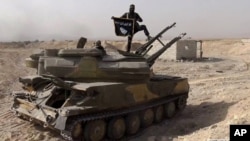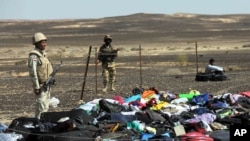The group behind the horrifying attacks in Paris has been spreading death and destruction in large parts of Iraq and Syria since 2013. The group, known alternately as Islamic State, ISIS, ISIL and Daesh, has become notorious for its brutality, including mass killings, abductions and beheadings.
We look at some facts behind its rise and spread.
What are its origins?
Islamic State got its start after the 2003 U.S. invasion of Iraq. The Jordanian militant Abu Musab al-Zarqawi aligned his Jama’at al-Tawhidw’al-Jihad with al-Qaida, calling it al-Qaida in Iraq.
After Zarqawi's death in a U.S. airstrike that year, his successors rebranded AQI as the Islamic State of Iraq and Syria (ISIS) or the Islamic State of Iraq and the Levant (ISIL). The group is known to its followers as il-Dawla (“the State”) and its Arabic-speaking detractors as Daesh, the Arabic equivalent of the acronym ISIS.
How did it expand?
Islamic State’s current leader, Abu Bakr al-Baghdadi, began rebuilding IS's capabilities after taking power in 2010. Baghdadi spent time in U.S.-run prisons in Iraq. Cells organized inside those prisons, along with remnants of Saddam Hussein’s ousted secular nationalist Ba’ath party, now make up some of Islamic State’s ranks.
In 2013, IS took advantage of the chaos caused by Syria's ongoing civil war to expand beyond Iraq's borders and recruit vast numbers of Syrian rebels.
The group went on to a string of successful missions, including wresting control of the Syrian city of Raqqa from Syrian President Bashar al-Assad's army.
At the end of 2013, it shifted its focus back to Iraq and exploited a political standoff between the Shia-led government and the minority Sunni Arab community. Aided by tribesmen and former Saddam Hussein loyalists, IS took control of the central city of Fallujah.
In June 2014, after consolidating its hold over dozens of cities and towns across Iraq and Syria, IS declared the creation of a caliphate and changed its name to "Islamic State."
What does it want?
Having established a caliphate, Islamic State now believes it is the duty of all Muslims to emigrate to it and renounce their citizenship in any other nation. It regards any form of government other than its own as anathema to Islam.
After the caliphate was announced, IS began describing al-Baghdadi as a ”leader for Muslims everywhere,” an idea met with outrage and horror by the majority of the Muslim world.
IS supporters actively welcome the prospect of Western intervention, which they believe will hasten their final victory in the ultimate war between the armies of a non-Islamic force and the armies of Islam in northern Syria.
How is it funded?
The group makes its money through oil smuggling in Syria, racketeering and kidnappings, as well as donations from private jihadi networks in the Gulf.
The U.S. Treasury estimates that in 2014, IS may have earned as much as $100 million from the sale of crude oil and refined products to local middlemen, who in turn smuggled them into Turkey and Iran, or sold them to the Syrian government.
But air strikes on oil-related infrastructure are now believed to have diminished that revenue.
Kidnapping also generated at least $20 million in ransom payments in 2014. And it raises several million dollars per month through extorting the millions of people living in areas under its full or partial control.
Islamic State is believed to the wealthiest terrorist organization in the world.
Why is it so violent?
Islamic State members adhere to an extreme interpretation of Sunni Islam and consider themselves the only true believers. They hold that the rest of the world is made up of unbelievers who seek to destroy Islam, justifying attacks against other Muslims and non-Muslims alike.
The group has used beheadings, crucifixions and mass shootings to terrorize its enemies.
IS has held at least 23 Western hostages from 12 countries. The hostages have been tortured, executed and used as pawns in an ongoing propaganda effort.
Last year, the group released a series of graphic videos that showed militants beheading hostages, starting with James Foley, an American journalist.
Similarly, IS has instituted sex slavery and a theology of rape in areas under its control. Claiming the Quran’s support, the militants have enslaved women and girls from the Yazidi religious minority in particular.
More than 3,000 Yazidi women are believed to be held by IS. Some who managed to escape captivity or were rescued report being rated according to desirability, labeled and transported across IS-held territory to be traded between fighters, and awarded by leadership as prizes.
How far is its reach?
Islamic State has demonstrated a sophisticated worldwide reach. Using social media, it recruits fighters and supporters, primarily young people, from around the world.
Along with its influence, it also is spreading violence and death.
Earlier this month, an IS affiliate in Egypt claimed responsibility for an explosion that brought down a Russian passenger jet leaving the resort city of Sharm el-Sheikh, killing all 224 on board.
Last week, IS also claimed twin blasts in the Lebanese capital, Beirut, that killed at least 41 people.
Then Friday, the group unleashed several coordinated attacks in Paris, killing more than 130 people.








